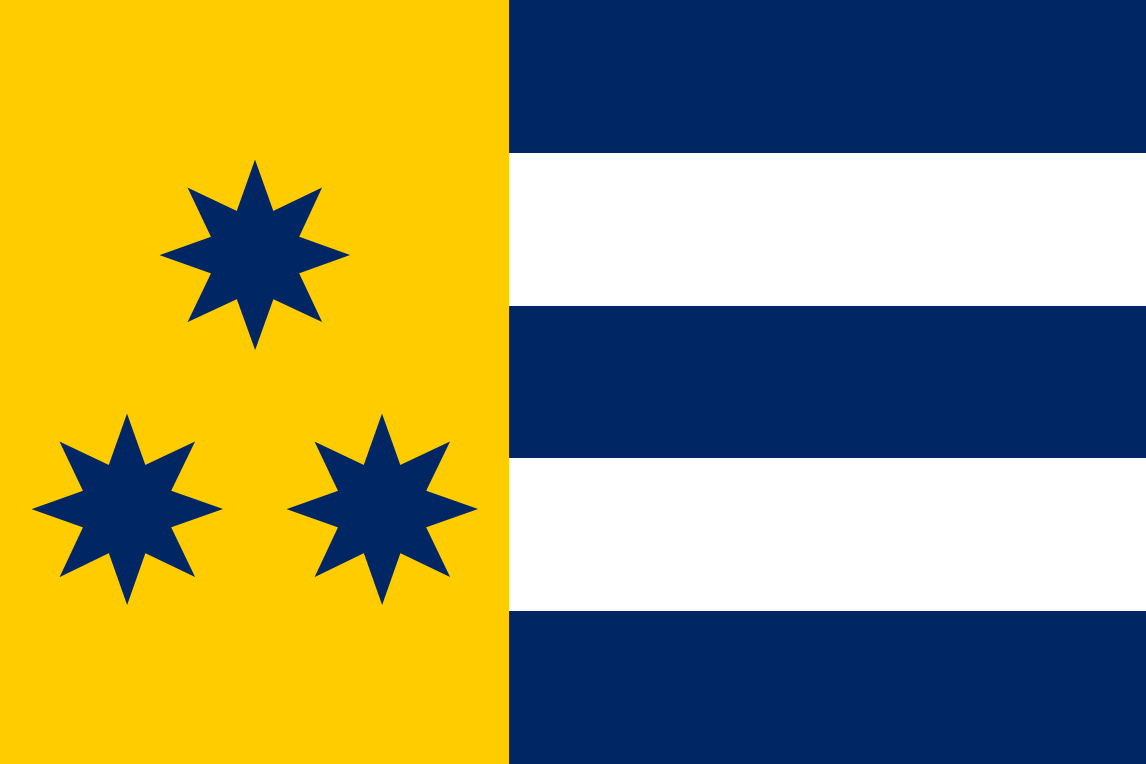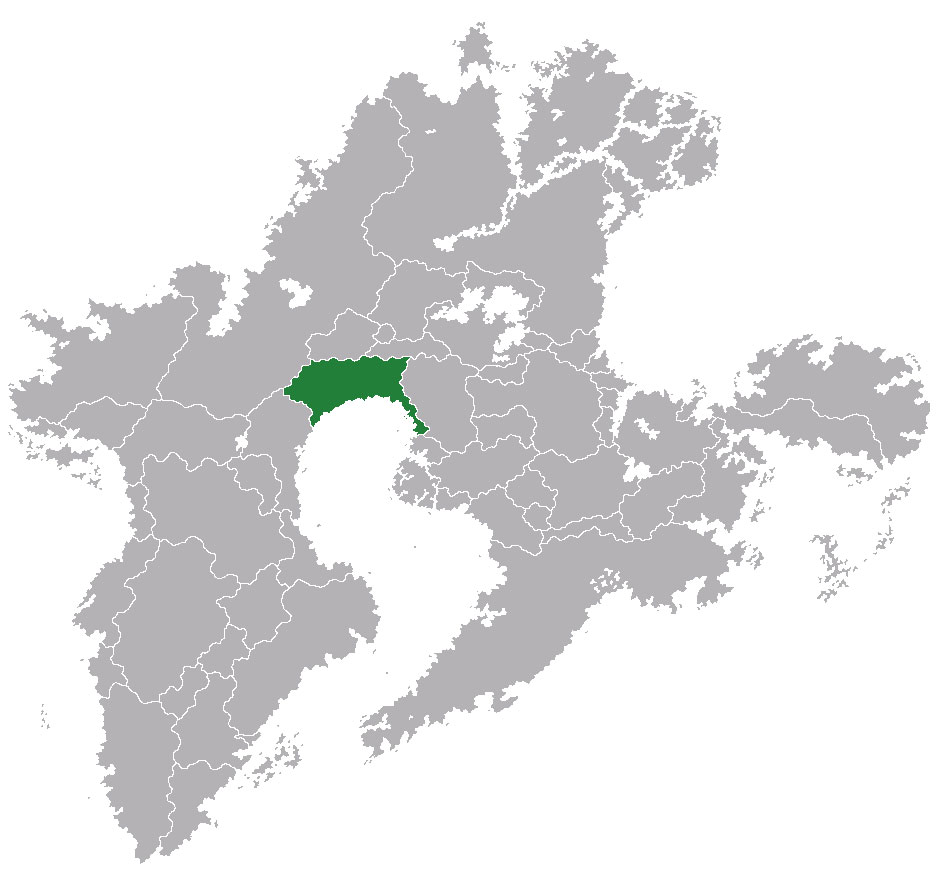What others discard, we care for and turn into something greater. Our strength comes from valuing everyone's right to live and to make a name for themselves.— Edgars, Volis of Aunas
The Federal State of Alinhas is a large and powerful country on the northern shores of
the Gulf, known for its tolerance and reverence of magic and those with the abilities to wield it. Led by a triumvirate of mighty and influential mages, each from one of the three federal states, Alinhas has emerged as a relatively new great power on the world stage. As the
Alinhasians are followers of
Baglāmēq Hūril, the Federal State also considers the protection of the faithful not just in Alinhas, but in all of
Lethea, an important priority, a stance that has embroiled them in a rivalry with another great power, the
Empire of Pallernen.
Politics
Alinhas is ruled by the
Volisis, a triumvirate of mages who hold absolute power over all state affairs. These great overlords are elected by regional councils roughly a month after the funeral of the previous representative from that region. A Volis is ideally supposed to be the best their region has to offer. They must compromise with their counterparts in a civil manner, always remembering to keep their three primary responsibilities in balance. They must serve their home region's interests, keep the federal state united, and serve as an example to all who seek to follow in their footsteps.
In reality, the situation isn't quite as idealistic. The three regions often select their representatives from a small, tight-knit group of well-connected mages, leaving far more capable individuals out of the process in favour of the political elite. Rather than being exceptional role models for the country's youth, many of them end up in wild scandals, often involving allegations of corruption, debauchery, or other wild displays of incompetence.
Federal Regions
Before the country was united under the same flag, three major powers dominated the territories inhabited by the Alinhasian people. The wildest of the regions, Heinas, controlled the northeastern highlands and forests. To their south was Vesis, a land of merchants and mercenaries that was regularly forced to defend their people from their northern neighbour. While the two powers contested over the region, a third power gathered its strength in the west.
Aunas, the borderland that guarded the rest against an endless stream of migration from the
Rahigina, had fortified their borders and established themselves as a strong country capable of great deeds.
Eventually, when both their neighbours had suffered tremendous losses fighting against one another, the forces of Aunas swept in, toppling the governments of Heinas and Vesis, giving birth to a new united Alinhas. Despite their best efforts to stabilize the country, regional identities remain strong, and the three groups of people are distrustful of each other.
List of Districts in Aunas
| Administrative Division |
Population |
Status |
| Lieti |
- |
Urban District |
| Gēldis |
- |
Rural District |
| Iesu |
- |
Rural District |
| Nelsgara |
- |
Rural District |
| Litē |
- |
Rural District |
| Vatūja |
- |
Rural District |
| Lower Aunas |
- |
Rural District |
| Upper Aunas |
- |
Rural District |
| Jergis |
- |
Rural District |
| Rojalisis |
- |
Rural District |
| Marsia |
- |
Rural District |
| Tārsis |
- |
Rural District |
| Ralmingauda |
- |
Rural District |
List of Districts in Heinas
| Administrative Division |
Population |
Status |
| Heinas |
- |
Urban District |
| Belika |
- |
Rural District |
| Karjesi |
- |
Rural District |
| Lovinje |
- |
Rural District |
| Anespē |
- |
Rural District |
| Riakas |
- |
Rural District |
| Kanispēdeia |
- |
Rural District |
List of Districts in Vesis
| Administrative Division |
Population |
Status |
| Vīja |
- |
Urban District |
| Valnusis |
- |
Rural District |
| Velkauda |
- |
Rural District |
| Lower Vesis |
- |
Rural District |
| Torisa |
- |
Rural District |
| Tilnisis |
- |
Rural District |
You can't just go around talking about whatever's on your mind. We all know what you're thinking — we've got the same ideas. It's just that our benevolent overlords would prefer us to keep our complaints to ourselves.— Voldemars of Heinas
Federalists & Regionalists
The divide between the federalists and regionalists has defined the political landscape of the country. Everyone is somewhere on that scale, whether they wish for a stronger union, more autonomy, or just the continuation of the status quo. The government itself mostly consists of federalists, but there's also a minority of centrists and moderate regionalists.
Not all on the regionalist side of the spectrum are content with increased autonomy. There are some who wish to break free from the chains that bind their region to Alinhas. Such separatists want to fight a war for their independence. The federal government persecutes these extremists as they are considered a severe threat to the existence of the country itself.
Radical federalists, on the other hand, wish to further the process of integration. They believe that a strong and stable unitary state could achieve far greater things. Although not officially targeted by the authorities, these extremists are still ridiculed as traitors to the federalist cause by those moderates who wish for a peaceful union between the three distinct regions. Radical federalists are often called unitarianists by the other federalists, but most regionalists and even some of the centrists insist on associating them with the federalists.
Military
The Federal State of Alinhas uses a small elite force to maintain order and to suppress dissidents. Much to the chagrin of the unitarianists who would like them disbanded, each region is allowed to maintain a small army so that they can defend their borders. In case of war or other large-scale emergencies, the federal government will have the right to order the regions to put together a larger army, but those armies will be under the command of loyal federalists instead of their local leaders.
Maritime Cooperation
In addition to their small standing army, the Alinhasians are also known for their naval prowess. They use their large fleet to protect merchants along the vital trade networks that carry goods from abroad along the Great Gulf, bringing wealth and prosperity to the Alinhasian people. Due to close relations with the nearby
Aristocratic Republic of Rueken, the two powers are often cooperating to eliminate piracy and other illegal activities in the region.
Tolerance of Vitality Mages
While most countries concider
vitality magic dangerous and unreliable, the Alinhasians disagree with the notion. Their army utilizes small units of elite
vitatiers called the
Mētia Arīsi. Such units are used to hunt down enemy leaders on the field of battle, severing the head of the hostile army.
Symbols
The flag of Alinhas has three blue eight-sided stars on a golden background and to the right of that, three blue horizontal lines on a white background. The three eight-sided stars represent the three states that the country is divided into, and the eight-sided star is a symbol for mankind. The blue lines represent the three largest and most important rivers that flow through the country; Aunas, Vesis, and Nelsis, and the white lines are for the great cities of Lieti and Heinas. The golden background represents the fertile wheat fields of Kanispēdeia.
Demoraphics
What hopes do we have of regaining the freedoms we’ve lost? The realms around us are filled with deceitful cowards, eager to submit to the Alinhasian bastards. Athe will not ride to war in our aid, Pallernen is half-way across the continent, and the Ausselians, although sympathetic, are too few in number.— Einasi separatist
Located in an area where the lush and civilised lands meet the harsh and hostile deserts of the west, the demographics of Alinhas have been significantly affected by the large-scale migrations that have occurred over the ages. The modern day people that call Alinhas their home are a diverse mix of various peoples that have arrived in the area, often shedding the blood of those who came before them, striving to claim the fertile fields for their own. Traces of some of the assimilated cultures and languages can still be found in regional traditions and dialects.
Tribal Peoples
Along the borders of the country and in the forests and hills of Heinas live the
Einasi,
Lorati, and the
Tarolians. Their people had lived in tribal societies, resisting the feudal structures that their Alinhasian neighbours has adopted. Before the three regions united and formed the Federal State, many of these tribal peoples enjoyed special privileges that allowed them to continue living as their ancestors had, but the new federal government disapproved, judging them as backwards traditions that hindered development. Under the rule of Alinhas, these tribal minorities were forced to relinquish their old rights. New laws were enacted, forcing many to emigrate or to adapt to the new order, but not all of them were as complacent as the Alinhasians had hoped.
Einasi Resistance
The Einasi, a people who were once treated equally under the flag of Heinas, chose to resist. They struck out against federal forces from their hideouts in the hills and woods. The local populace was initially supportive of them — offering food, clothes, and other necessary supplies to their valiant fighters. That all changed, however, when the federal army began to target civilians suspected of collaborating with treasonous groups and individuals. Those loyal to the state were greatly rewarded for turning on their neighbours if they saw or heard anything vaguely suspicious. Eventually, the separatists had lost the support of the peopele, demoralising them severely. Most had given up hope soon after, yet a few still remain, keeping the fires of freedom burning.





Comments